Today, Memorial Day is part of the three-day weekend each May that signals the beginning of summer, and is marked by beach trips and backyard barbecues. But Memorial Day was originally instituted after the Civil War to honor war veterans, and was eventually made into a day of remembrance for all who died in service to their country.
The Origins of Memorial Day
Decoration Day, as Memorial Day was originally known, was first held on May 5, 1868, three years after the end of the Civil War. The Grand Army of the Republic (GAR), an organization of Union veterans, instituted the day to honor their deceased peers by decorating their graves with fresh flowers. Maj. Gen. John A. Logan later changed the date to May 30. “It is believed that date was chosen because flowers would be in bloom all over the country,” the Veterans Affairs Web site reports.
The first national observance of the holiday took place on May 30, 1868, at Arlington National Cemetery in Washington, D.C., honoring soldiers from both the Union and the Confederacy who were buried there. It wasn’t until 1971 that federal law changed observance of Memorial Day to the last Monday in May and made it part of a three day weekend, in keeping with the way it is celebrated today. The law also extended the day’s meaning to honor soldiers who died in all American wars, not just the Civil War.
Sources in this Story:
- U.S. Department of Veterans Affairs: Memorial Day History
- Library of Congress: Today in History – May 30
- Veterans of Foreign Wars of the United States: Buddy Poppy
- American Veterans Center: National Memorial Day Parade
Memorial Day Through the Years: The “Buddy Poppy” Initiative
One of the symbols traditionally associated with Memorial Day is the poppy flower, dating back to the 1915 poem “In Flanders Field,” written by World War I Canadian Col. John McCrae. The poem mourns the many soldiers who died during the Flanders campaigns, and, according to the U.S. Department of Veteran Affairs, “presented a striking image of the bright red flowers blooming among the rows of white crosses.”
Eventually, the poppy became associated with the holiday in a very meaningful way. In 1922, the Veterans of Foreign Wars in the United States (VFW) adopted the poppy as its official memorial flower. According to the VFW Web site, the VFW began their own production of artificial poppies by hiring “disabled and needy veterans who would be paid for their work” to make the poppies. By 1923, the initiative became known as the “Buddy Poppy” program. It has been active for more than 75 years and still distributes poppies through veteran organizations across the U.S. Buddy Poppy proceeds have amounted to millions of dollars for the support of orphans, war veterans and their widows.
Modern Memorial Day Celebrations
Today, Memorial Day is a family holiday that marks the beginning of the summer season, and the three-day weekend is usually celebrated with barbecues, picnics and trips.
But the holiday’s meaning has not been lost. Cities throughout the U.S. organize parades to commemorate the day and fly the American flag at half-mast to honor those who have died. The National Memorial Day Parade, held in Washington, D.C., is our nation’s largest Memorial Day event, drawing hundreds of thousands of spectators to the National Mall to pay tribute to those who have sacrificed for our country. The American Veterans Center website contains detailed information about the parade and states that the family-friendly event calls “attention to the true meaning of Memorial Day – honoring our fallen heroes.”
This article was originally written by Ana Gutierrez-Folch; it was updated on May 23, 2017.
















